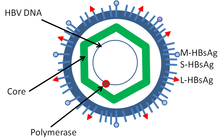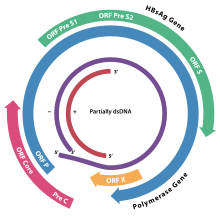
Back مولد الضد اللبي لالتهاب الكبد ب Arabic HBcAg German HBcAg Spanish HBcAg Ukrainian 乙型肝炎核心抗原 Chinese
| Capsid protein | |||||||
|---|---|---|---|---|---|---|---|
| Identifiers | |||||||
| Organism | |||||||
| Symbol | C | ||||||
| UniProt | Q9QAB9 | ||||||
| |||||||
| Hepatitis core antigen | |||||||||
|---|---|---|---|---|---|---|---|---|---|
| Identifiers | |||||||||
| Symbol | Hepatitis_core | ||||||||
| Pfam | PF00906 | ||||||||
| InterPro | IPR002006 | ||||||||
| CATH | 7abl | ||||||||
| SCOP2 | 7abl / SCOPe / SUPFAM | ||||||||
| |||||||||


HBcAg (core antigen) is a hepatitis B viral protein.[1][2] It is an indicator of active viral replication; this means the person infected with Hepatitis B can likely transmit the virus on to another person (i.e. the person is infectious).
- ^ Kimura T, Rokuhara A, Matsumoto A, et al. (May 2003). "New enzyme immunoassay for detection of hepatitis B virus core antigen (HBcAg) and relation between levels of HBcAg and HBV DNA". J. Clin. Microbiol. 41 (5): 1901–6. doi:10.1128/JCM.41.5.1901-1906.2003. PMC 154683. PMID 12734224.
- ^ Cao T, Meuleman P, Desombere I, Sällberg M, Leroux-Roels G (December 2001). "In vivo inhibition of anti-hepatitis B virus core antigen (HBcAg) immunoglobulin G production by HBcAg-specific CD4(+) Th1-type T-cell clones in a hu-PBL-NOD/SCID mouse model". J. Virol. 75 (23): 11449–56. doi:10.1128/JVI.75.23.11449-11456.2001. PMC 114731. PMID 11689626.